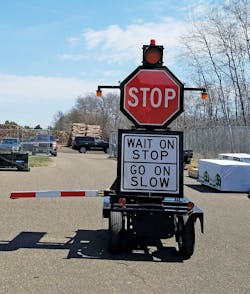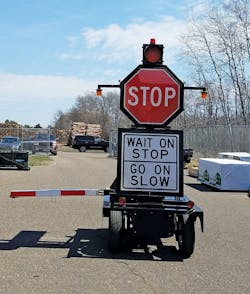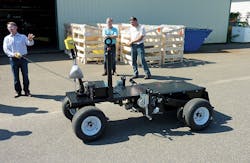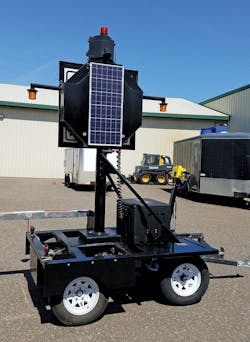Safe way to go
Flagging operations are a critical part of construction and maintenance activities on our highways.
Flagging personnel are trained to effectively and safely communicate the location of construction or maintenance activities to the traveling public. Due to the nature of the work, flagging personnel are located on the roadway near the work zone, which can result in dangerous vehicle and flagger interactions. With the increasing numbers of distracted drivers, safety of flaggers and workers in work zones is a growing concern. Unfortunately, flagging personnel deaths and near misses continue to occur on our highways during each construction season.
Moving operations involve work zones that are continuously moving, such as pavement crack-sealing operations. The use of traditional automated flagger-assistance devices (AFADs) in a moving operation is difficult due to the towing requirements of the devices. To capture the benefits of AFADs in a moving work zone, the Minnesota Department of Transportation (MnDOT) determined the stationary AFAD needed to be modified to allow for self-propelled motion to follow the moving operation.
To address this issue, MnDOT and Wenck Associates Inc. completed a research project that included the following tasks:
- Determination of the need for the device;
- Review of similar devices already on the market;
- Design of the prototype device;
- Fabrication of the final device; and
- Documentation of device operations.
MnDOT’s mobile automated flagger-assistance device used for the study.
Device development
The stationary AFAD that MnDOT uses is the AutoFlagger, which is manufactured by Safety Technologies Inc. An initial meeting was held with Safety Technologies Inc. to discuss the possibility of developing a moving AFAD device. Discussion at the meeting included developing requirements for the device, including moving speed, device controls and range of motion. It was concluded that a review of existing devices already on the market would be conducted to determine if any devices were worth pursuing further.
Existing devices already on the market were reviewed to determine how they might work in a moving operation. Most of these devices were designed for moving recreational vehicles and trailers without the use of a towing vehicle. After a review of each device, it was decided to contact DJ Products Inc. to inquire about its line of cart-mover products. DJ Products Inc. is located in Little Falls, Minn., making contact convenient and quick.
A meeting was held at DJ Products Inc. headquarters, which also houses the company’s manufacturing operations. A variety of existing devices were reviewed, including devices developed to move multiple shopping carts at retail stores and another device used at airports. Discussion at the meeting led to an agreement to develop a prototype vehicle that could ultimately be used for the moving AFAD device.
Over the next six months, DJ Products Inc. developed a prototype device that could be outfitted with the AFAD equipment. Initial design drawings were developed as a guide for the device. The design was modified to incorporate all the necessary components and requirements for the AFAD equipment. The prototype was completed in August 2015, and a meeting was held at DJ Products Inc. to review the device.
At the meeting, the mobile device was reviewed and tested. The device could be controlled remotely or with the drive handle. It was large enough to accommodate the flagger components and could be towed behind a vehicle. Potential improvements to the device were discussed to better suit MnDOT’s needs. The device was brought back into the shop to implement the improvements.
The moving AFAD was completed in April 2016 and a meeting was held at DJ Products Inc. to review the device. All components from an automated flagger were transferred from the trailer to the new device. Operational features of the moving AFAD include:
- Operates with wireless remote, wired remote or handle controls;
- Uses the original remote control for the flagging components;
- On-board batteries and battery charger;
- Moves in forward and reverse directions at speeds up to 5 ft per second;
- Towed to the worksite using standard towing hitch; and
- Will operate for a minimum of six hours on initial charge.
A trailer (top), operable by remote, was built to carry the autoflagger rig (above).
Nothing that can’t be fixed
After final delivery of the device to MnDOT in May 2016, plans were made to test the device in the field. However, due to scheduling and operational issues that occurred, initial field testing was not completed in 2016. Operational issues were experienced that delayed the initial field testing. In June 2016, the on-board batteries failed and were replaced. The battery failure was possibly due to the amount of time that had lapsed since the device had last been charged and used. Storing the device in a location where the batteries can be continuously charged and maintained would eliminate this issue.
In addition, other replacement parts were needed, including a new control board. While waiting for the parts, the control box filled with water during a rain event, resulting in additional damage. The device was returned to DJ Products Inc. in October 2016 for repairs. To avoid future water damage, the seals for the control cover were improved and drain holes were installed in the control box to allow water to escape.
On Feb. 13, 2017, the device was used for flagging on a roadway crack-sealing project on TH 71 south of Sauk Centre, Minn. The device operated as expected and was used for about an hour on the project. Due to the type of crack sealing being performed, the crew was required to move at a faster rate than the device could accommodate. The required speed resulted in some drivability issues with oversteer while moving against traffic. After one hour of use, the device was removed from the project.
Being able to steer
The moving AFAD device is still being tested by MnDOT. Further modifications are being investigated, including enhancement of the battery pack to allow for longer operating times. Steering and controller design also will likely be modified. Currently, the moving AFAD must be steered from its rear traffic-facing axle, forcing the remote operator to guide it in a manner similar to backing up a boat trailer. Redesigning the device to be steerable from the traffic-leading end of the vehicle would allow for more intuitive control. MnDOT personnel also would like to see the device’s controller integrated with the sign controller, eliminating the need for two remote controls.
The full study report can be found at:
http://dotapp7.dot.state.mn.us/projectPages/pages/projectDetails.jsf?id=39357&type=DOCUMENT.



